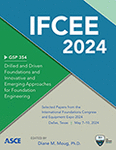Developed Predictive Design Equations for Drilled Shaft Capacities for Various Rock Formations by Conducting Site Investigation and Load Test
Publication: IFCEE 2024
ABSTRACT
Engineering strength properties of various rock formations vary significantly, and the data is typically scattered. Graphical and statistical measures are beneficial in summarizing and understanding such scatter and variation in strength properties. These techniques were used to predict rock engineering parameters, parameter distribution, and best-fit correlations among the parameters. The main objective of this study is to develop new design charts and prediction equations for various geologic formations to be used for drilled shaft design and rock strength property determination. In order to develop the regression equations, two databases were collected from 22 projects consisting of site investigation database and load test database. These projects included four geologic formations: shale, woodbine shale, woodbine sandstone, and limestone. Each geologic formation dataset was then subdivided into three types of classifications based on Federal Highway Administration (FHWA)’s rock classification system that uses unconfined compressive strength (Qun) and rock quality designation (RQD). After that, the database was subdivided further into sub-datasets, according to the level of weathering: hard or fresh, moderately weathered, or weathered. This paper discussed the statistical analyses and regressions for the field and laboratory parameters. Numerical and regression modelling of the rock properties and strength were considered to develop numerous equations for rock properties, strength, and drilled shaft bearing capacities, as well as equations for predicting TCP, Qun, skin friction, and end bearing for various geologic formations.
Get full access to this chapter
View all available purchase options and get full access to this chapter.
REFERENCES
AASHTO. LRFD Bridge Design Specifications. 8th (2017) and 9th (2020) Edition, American Association of State Highway and Transportation Officials, Washington, DC.
Abu-Hejleh, N. M., O’Neill, M. W., Hanneman, D., and Attwooll, W. J. (2003). Improvement of the geotechnical axial design methodology for Colorado’s drilled shafts socketed in weak rocks. https://doi.org/10.3141/1936-12.
Dass, R. N., and Puri, V. K. “Load Tests on Drilled Shafts for Highway Bridges” (1998). International Conference on Case Histories in Geotechnical Engineering. 56. https://scholarsmine.mst.edu/icchge/4icchge/4icchge-session01/56.
Fellenius, B. H. (2001). What capacity value to choose from the results a static loading test. We have determined the capacity, then what? Deep Foundation Institute, Fulcrum, Winter 2001, pp. 19–22 and Fall 2001, pp. 23–26. https://www.fellenius.net/papers/230%20&%20240%20Analysis%20of%20Pile%20Capacity-DFI.pdf.
FHWA (Federal Highway Administration). “Geotechnical Engineering Circular NO. 5” Geotechnical site Characterization. 2017 - https://www.fhwa.dot.gov/engineering/geotech/library_listing.cfm.
FHWA (Federal Highway Administration). “Geotechnical Engineering Circular NO. 5” Evaluation of Soil and Rock Properties. 2002 - https://www.fhwa.dot.gov/engineering/geotech/library_listing.cfm.
FHWA (Federal Highway Administration). “Geotechnical Aspects of Pavements”, 2006 - https://www.fhwa.dot.gov/engineering/geotech/library_listing.cfm.
FHWA (Federal Highway Administration). “National Bridge Inventory – Highway Statistics 2020.” Office of Bridges and Structures. Last modified March 20, 2021, https://www.fhwa.dot.gov/bridge/nbi/ascii2020.cfm.
Fuller, F. M., and Hoy, H. E. (1970). “Pile load tests including quick-load test method, conventional methods, and interpretations.” Highway Research Record, (333).
Erik Loehr, J., Lutenegger, A., Rosenblad, B., and Boeckmann, A. (2016). Geotechnical Site Characterization.
Moon, N., O’Neill, M., and Vipulanandan, C. (2004). Correlation between Texas Cone Penetration (TCP) Values and Compressive Strength of Clay Shale in Texas. https://static.tti.tamu.edu/tti.tamu.edu/documents/0-4372-1.pdf.
Nam, M. S., and Vipulanandan, C. (2008). Roughness and Unit Side Resistances of Drilled Shafts Socketed in Clay Shale and Limestone. Journal of Geotechnical and Geoenvironmental Engineering, 134(9), 1272–1279. https://doi.org/10.1061/(asce)1090-0241(2008)134:9(1272).
Nam, M. S., and Vipulanandan, C. (2010). Relationship between Texas Cone Penetrometer Tests and Axial Resistances of Drilled Shafts Socketed in Clay Shale and Limestone. Journal of Geotechnical and Geoenvironmental Engineering, 136(8), 1161–1165. https://doi.org/10.1061/(asce)gt.1943-5606.0000318.
O’Neill, M. W., and Reese, L. C. (1999). “Drilled shafts: Construction procedures and design methods.”, Dept. of Transportation, Federal Highway Administration, Office of Implementation, McLean, VA.
Ott, L. (2001). An Introduction To Statistical Methods and Data Analysis.
Salman, H. PhD Thesis Dissertation-University of Texas Arlington 2021 - Utilizing load tests and site investigation data to predict design load capacities for drilled shafts in different geologic formations.
Salman, H., Puppala, A. J., and Chittoori, B. C. S. (2023). Utilizing Site Investigation and Load Tests to Predict Drilled Shaft Design Parameters and Capacities for Various Geological Formations. https://doi.org/10.1061/9780784484685.004.
TxDOT (Texas Department of Transportation). (2020). “Geotechnical Manual”. Austin, Texas. http://onlinemanuals.txdot.gov/txdotmanuals/geo/geo.pdf.
Thomas, M. G. (2007). Geotechnical Challenges of the Weak Shale Units of North Texas. Problematic Soils and Rocks and In Situ Characterization, 1, 1–8. https://doi.org/10.1061/40906(225)10.
USGS. Texas Geology Map. 2007. https://txpub.usgs.gov/txgeology/.
USDA. (2012). Engineering Classification of Rock Materials. Part 631. Washington DC. Natural Resources Conservation Service, U.S. Government Printing Office. https://directives.sc.egov.usda.gov/viewerFS.aspx?id=3848.
Information & Authors
Information
Published In
History
Published online: May 3, 2024
ASCE Technical Topics:
- Analysis (by type)
- Engineering fundamentals
- Geology
- Geomechanics
- Geotechnical engineering
- Geotechnical investigation
- Load tests
- Material mechanics
- Material properties
- Materials engineering
- Mathematics
- Parameters (statistics)
- Regression analysis
- Rock mechanics
- Rock properties
- Site investigation
- Statistical analysis (by type)
- Statistics
- Strength of materials
- Tests (by type)
Authors
Metrics & Citations
Metrics
Citations
Download citation
If you have the appropriate software installed, you can download article citation data to the citation manager of your choice. Simply select your manager software from the list below and click Download.
